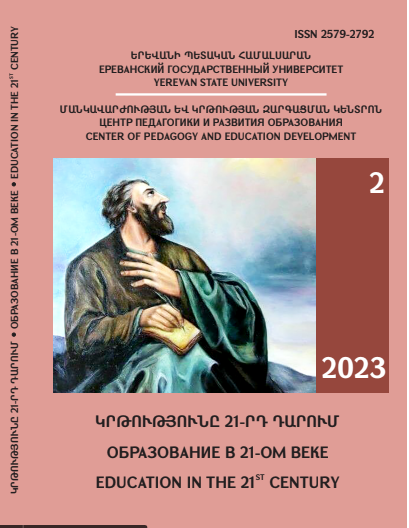PRINCIPLES OF INTERACTIVE LEARNING
DOI:
https://doi.org/10.46991/ai.2023.2.115Keywords:
educational process, learning technology, learning method, interactive learning, principles of interactive learning, learning based on interaction, interaction groups, interaction and mutual influence, self-expression, interaction skills, feedbackAbstract
The purpose of our research is to clearly define the principles of interactive learning, methods for the development of interaction skills, rules of implementation, stages of implementation and features of the use of interactive learning in a university course of the Armenian language.
The objective of the study is to reveal the essence of the principles of interactive learning, the advantages and limitations of the work carried out on the basis of the principles of interaction, pedagogical problems that arise when using methods and the ways of their solution.
General scientific logical, as well as private or special methods, i.e. the methods of analysis and comparison, were used during the comprehensive study of the problem put forward within the framework of the topic.
The principles of interactive learning, i.e. interaction and mutual learning, students activity, collaboration, encouragement of self-expression and feedback, create conditions for students activity, motivation, self-expression, interaction and cooperation. There are various methods for developing interaction skills: “Student Team Performance”, “Brainstorming”, “Excursion to an Art Gallery”, “Debate” and other methods, the use of which creates conditions for the encouragement and exchange of thoughts, ideas, analysis and discussion, the equality of students present in class, record of thoughts, which contributes to the solution of educational problems.
In interaction groups, students work together, expressing opinions and exchanging ideas. Work in such groups is based rather on cooperation than on competition. Each member of the learning group accomplishes the learning goals and objectives with the assistance of others, while helping them achieve their own goals and objectives. In this case, cooperation is not limited to discussions and is organized on the basis of the principles of interaction and mutual learning, which become the basis for the formation and application of other principles: the principle of self-expression and feedback.
When conducting the research, we came to the conclusion that the technology, methods and principles of interactive learning contribute to the formation of interaction in the classroom, encouraging each student to active participation in the learning process. The limitations caused by the principles of interactive learning can be overcome through the application of technologies and methods that are appropriate to the topic and learning objective.
References
Արնաուդյան Ա., Ուսուցչի կողմից սեփական մասնագիտական գործունեության հետա-զոտում և գնահատում // «Բանբեր Վ. Բրյուսովի անվան պետական համալսարանի», Երևան, 2020, թիվ 2(51), էջ 12-26:
Հովհաննիսյան Մ., Մտագրոհը՝ որպես ուսուցման փոխներգործուն (ինտերակտիվ) ուսուցման մեթոդ // «Գիտական Արցախ», Երևան, 2022, թիվ 1(12), էջ 188:
Հովհաննիսյան Ա., Հարությունյան Կ., Խրիմյան Մ., Խաչատրյան Ս., Բայաթյան Ն., Ալեք-սանյան Լ.,Պուրուկուրու Վ., Համագործակցային ուսուցում, Երևան, 2006, էջ 29-30: 4. Сластенин В.А. и др., Педагогика, Учеб. пособие для студ. высш. пед. учеб. заведений, Под ред. В.А. Сластенина. – М., 2002, с. 205.
Schmuck R. A., Schmuck P. A., Group processes in the classroom, USA, Oregon, 2000, 11-16, pp. 37-38.
Downloads
Published
How to Cite
Issue
Section
License
Copyright (c) 2023 Meri Hovhannisyan

This work is licensed under a Creative Commons Attribution-NonCommercial 4.0 International License.

